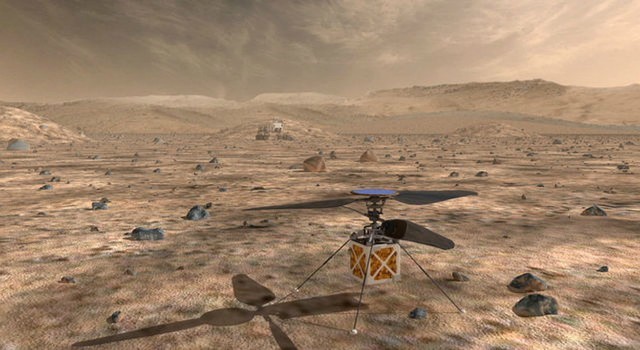Image: NASA’s Mars Helicopter, a small, autonomous rotorcraft, which will travel with the agency’s Mars 2020 rover, currently scheduled to launch in July 2020, to demonstrate the viability and potential of heavier-than-air vehicles on the Red Planet, is shown in this artist rendition from NASA/JPL in Pasadena, California, U.S. May 11, 2018. Courtesy NASA/JPL-Caltech/Handout via REUTERS
![]()
By Will Dunham
WASHINGTON (Reuters) – NASA said on Friday it will send a small helicopter to Mars as part of the U.S. space agency’s 2020 mission to place a next-generation rover on the Martian surface, marking the first time such an aircraft will be used on another world.
The remote-controlled Mars Helicopter, designed to take flight in the thin Martian atmosphere with twin counter-rotating blades, weighs about four pounds (1.8 kilograms), with a fuselage the size of a softball, NASA said. Its blades will spin at almost 3,000 rpm, roughly 10 times the rate employed by helicopters on Earth.
“The altitude record for a helicopter flying here on Earth is about 40,000 feet (12,200 meters). The atmosphere of Mars is only one percent that of Earth, so when our helicopter is on the Martian surface, it’s already at the Earth equivalent of 100,000 feet (30,480 meters) up,” Mimi Aung, the Mars Helicopter project manager at NASA’s Jet Propulsion Laboratory, said in a statement.
NASA officials said the rotorcraft will reach the Red Planet’s surface attached to the car-sized rover. After placing the helicopter on the ground, the rover will be directed to drive to a safe distance to relay commands. Controllers on Earth will command the helicopter to take its first autonomous flight after its batteries are charged and tests are conducted, NASA said.
“The idea of a helicopter flying the skies of another planet is thrilling,” NASA Administrator Jim Bridenstine said in a statement.
The helicopter is intended to demonstrate the viability and usefulness of such aircraft on Mars, NASA said, with potential roles as a low-flying scout or to reach locations inaccessible from the ground.
NASA said it plans a 30-day flight test period that will include up to five flights, starting with a short vertical jaunt to hover for about 30 seconds at an altitude of 10 feet (3 meters) and progressing to flight distances up to a few hundred yards and durations up to 90 seconds.
The helicopter contains solar cells to charge its lithium-ion batteries and a heating mechanism to keep it warm during frigid nights.
The Mars 2020 rover mission is scheduled to launch in July 2020 from Cape Canaveral Air Force Station in Florida and reach Mars in February 2021. The rover is designed to carry out geological studies and ascertain the habitability of the Martian environment, NASA said.
(Reporting by Will Dunham, Editing by Rosalba O’Brien)
Copyright 2018 Thomson Reuters. Click for Restrictions.


